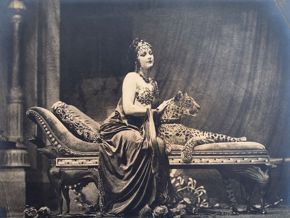The King of Kings January 19, 2022

The King of Kings “The Magdalene”
The King of Kings “The Woman Taken in Adultery”
The King of Kings “Mary’s Farewell to Her Son”
The King of Kings “Christ Before Pilate”
The King of Kings “The Betrayal”
The King of Kings “The Repentant Judas”
The King of Kings “Calvary”
The King of Kings “It Is Finished”
The King of Kings, 1927
A Rare Book of Photographs by William Mortensen
With a cast of thousands and over-the-top scenery, Cecil B. DeMille’s epic film The King of Kings recounts the final episodes of the life of Christ. The film remains as impressive now as it was on May 18, 1927, the day it premiered as the first movie shown at Grauman’s Chinese Theatre in Hollywood. Throughout the making of the film in 1926 and 1927, photographer William Mortensen (American, 1897–1965) shot nearly 5,000 images. These photographs included close-up portrait studies of the principal actors (H. B. Warner as Jesus, Jacqueline Logan as Mary Magdalene, Joseph Schildkraut as Judas, and others), restaged scenes, and—unprecedented for the time—stills taken on set during the filming of the most spectacular sequences. So impressed was DeMille with the results that he commissioned Mortensen to produce prints for a privately published book with 60 tipped-in photographs and a production run of 50 copies. The Museum of Fine Arts, Houston, has just acquired a rare example, now on display in the newly renovated Anne Wilkes Tucker Photography Study Center.
Taking the Picture / Making the Picture
Like turn-of-the-20th-century Pictorialist photographers, Mortensen (born 125 years ago this week) believed his original negatives to be merely a starting point that, through retouching, drawing, hand-coloring, and other manipulation, could reach their full expressive potential. “Getting the image onto the negative,” he wrote, “is only taking the picture: in printing, one comes to making the picture.” Indeed, his photographs often appear more like drawings or etchings—a characteristic anathema to his purist contemporaries such as Ansel Adams, who called him “the Anti-Christ.” Despite the derision of photographers in the period’s budding Modernist circles, Mortensen’s heavily manipulated images enjoyed enormous success in the late 1920s and 1930s. He published more than a dozen books (most of which are available in the Museum’s Hirsch Library), and his images were widely exhibited and reproduced. After falling out of favor for much of the 20th century, Mortensen’s photographs have now reemerged as precursors of the staged tableaux and Photoshopped images common in recent years.
The Photographs Tell the Story
With his background as a painter and photographer of Hollywood sets and as the in-house photographer for Wescosco (Western Costume Co.), Mortensen had already developed a romantic sensibility and stylistic predilection for theatricality that proved to be a perfect visual language for translating the broad gestures, exaggerated expressions, and grand spectacle characteristic of DeMille’s movies. The book that DeMille commissioned bears titles and biblical passages in Old English letterpress opposite each picture—but Mortensen’s photographs alone could tell the story.
An Intriguing Inscription
The MFAH copy of The King of Kings, one of only four known in public collections, is inscribed by DeMille to journalist John J. Flinn, “one who understands, and with thanks for the splendid help of your son.” One wonders what DeMille truly thought about the “splendid help” of Flinn’s son, John C. Flinn, president of Pathé Exchange, which owned the film. It was the younger Flinn who pushed the director to cut The King of Kings from 155 minutes to just 112, who required DeMille to remove scenes that were criticized as ahistorical and anti-Semitic before wide distribution in the United States, and who determined that the film would not be distributed in “those areas (particularly Poland, Hungary, Czecho-Slovakia and Roumania) where race hatred might be engendered.”
Stay Tuned
The acquisition of the elaborately produced volume of The King of Kings adds an important body of work to the Museum’s existing collection of photographs by Mortensen—beauty shots, costume pieces, and political images, many of which were 2018 gifts of Mortensen authority, enthusiast, and gallerist Stephen Romano. Perhaps surprisingly, at the same time that Mortensen was making the deeply reverent photographs found in The King of Kings, he began work on a very different project in which his masterful if unusual technique gave expression to a brew of theatricality, eroticism, and grotesquery. As museum curators, we are always on the lookout for the next acquisition, and pictures from Mortensen’s planned Pictorial History of Witchcraft and Demonology are definitely on our desiderata list. Stay tuned.
• Learn more about the Anne Wilkes Tucker Photography Study Center





